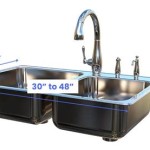Top Mount Farmhouse Kitchen Sink: A Comprehensive Guide
The top mount, also known as drop-in or overmount, farmhouse kitchen sink represents a popular configuration for homeowners seeking a blend of traditional aesthetics and ease of installation. Unlike undermount sinks, which are installed beneath the countertop, top mount farmhouse sinks are designed with a visible flange that sits on top of the countertop surface. This design characteristic presents various advantages and considerations for both installation and everyday use. This article aims to provide a comprehensive overview of top mount farmhouse kitchen sinks, covering their key features, benefits, drawbacks, installation process, and factors to consider when selecting the appropriate model.
Understanding the Top Mount Farmhouse Sink Design
The defining characteristic of a top mount farmhouse sink is its exposed rim. This rim, or flange, rests directly on the countertop, creating a visible lip around the sink's perimeter. This design differs significantly from the seamless aesthetic of undermount sinks, where the countertop material extends directly to the sink basin. Top mount farmhouse sinks retain the signature deep basin and apron front of traditional farmhouse sinks, combining these features with the simple installation associated with top mount configurations. The apron front, also known as the farmhouse front, is the exposed front of the sink, adding a distinct focal point to the kitchen.
The materials used in top mount farmhouse sinks are diverse, ranging from traditional fireclay and cast iron to more contemporary stainless steel and composite materials. Each material offers distinct properties in terms of durability, heat resistance, stain resistance, and aesthetic appeal. Fireclay sinks, known for their classic look and durability, are a popular choice for farmhouse sinks. Cast iron sinks, often coated with enamel, offer excellent heat retention and a traditional feel. Stainless steel sinks provide a modern, easy-to-clean option, while composite sinks offer a balance of durability and affordability.
The size and configuration of top mount farmhouse sinks can also vary considerably. Single-basin sinks are ideal for maximizing space for washing large pots and pans, while double-basin sinks provide separate compartments for washing and rinsing. The depth of the basin is another important consideration, as deeper basins offer greater capacity for handling large items. Overall dimensions should be carefully considered to ensure the sink fits comfortably within the designated cabinet space and complements the overall kitchen design.
Advantages of Choosing a Top Mount Farmhouse Sink
One of the primary advantages of a top mount farmhouse sink is its ease of installation. Unlike undermount sinks, which require precise countertop cutouts and skilled installation to ensure a watertight seal, top mount sinks can be installed relatively easily. The exposed rim provides a degree of tolerance for slight imperfections in the countertop cutout. The rim also acts as a support structure, distributing the weight of the sink across the countertop. This simpler installation process can lead to reduced installation costs and makes it suitable for DIY enthusiasts with moderate plumbing experience.
Another key benefit of top mount sinks is their compatibility with a wider range of countertop materials. While undermount sinks require solid surface countertops such as granite, quartz, or solid acrylic, top mount sinks can be installed with laminate or even some types of tile countertops. The exposed rim covers the exposed edge of the countertop cutout, eliminating the need for a perfectly finished edge. This makes top mount sinks a viable option for homeowners with budget constraints or those renovating kitchens with existing laminate countertops.
Top mount farmhouse sinks also offer practical advantages in terms of maintenance. The raised rim helps prevent water from spilling onto the countertop, containing splashes and drips within the sink basin. This feature reduces the risk of water damage to the countertop surface and makes cleanup easier. The visible rim also provides a clear demarcation between the sink and the countertop, making it easier to maintain hygiene and prevent the buildup of grime and mildew.
Potential Drawbacks of Top Mount Farmhouse Sinks
While top mount farmhouse sinks offer various advantages, it is important to acknowledge their potential drawbacks. One of the main concerns is their aesthetic appearance. The visible rim can detract from the seamless, streamlined look that many homeowners desire. The exposed rim can also accumulate dirt and grime, requiring regular cleaning to maintain its appearance. This is particularly true for sinks with intricate rim designs or textured surfaces.
Another potential drawback is the slight lip created by the rim. This lip can interfere with wiping crumbs and spills directly into the sink. Instead, users may need to lift food debris over the rim, which can be less convenient than simply wiping it into an undermount sink. The height of the rim can also be a concern for users with mobility issues, as it may require more effort to reach into the sink basin. The rim can also create a small shadow line, which some find less appealing than a flush countertop surface.
Compatibility with certain kitchen styles can also be a limiting factor. While farmhouse sinks are generally well-suited for traditional and rustic kitchens, they may not be the best choice for ultra-modern or minimalist designs. The bulky apron front and exposed rim can clash with the clean lines and sleek surfaces that characterize contemporary kitchens. Therefore, it is essential to consider the overall design aesthetic of the kitchen when deciding whether a top mount farmhouse sink is the right choice.
Installation Considerations for Top Mount Farmhouse Sinks
Proper installation is crucial to ensure the functionality and longevity of a top mount farmhouse sink. The first step is to carefully measure the sink and countertop to determine the appropriate cutout size. The manufacturer's specifications should be consulted to ensure accurate dimensions. The cutout should be slightly smaller than the sink's outer dimensions to allow the rim to rest securely on the countertop. A template is often provided with the sink to facilitate the cutout process.
Once the cutout is made, the sink can be lowered into place from above. A bead of silicone sealant is typically applied to the underside of the rim to create a watertight seal between the sink and the countertop. Clamps or weights may be used to hold the sink in place while the sealant cures. Excess sealant should be wiped away with a damp cloth. Plumbing connections for the faucet, drain, and garbage disposal should be installed according to standard plumbing practices. It is recommended to consult with a qualified plumber if there is any uncertainty about the plumbing connections.
The apron front of the sink should be properly supported to prevent sagging. This may require custom cabinetry or modifications to existing cabinets. The cabinet beneath the sink should be sturdy enough to support the combined weight of the sink, water, and any items placed inside the basin. Adjustable legs can be used to ensure the sink is level and aligned with the countertop. Careful attention to detail during the installation process will ensure a secure and aesthetically pleasing result.
Factors to Consider When Selecting a Top Mount Farmhouse Sink
Several factors should be considered when selecting a top mount farmhouse sink to ensure it meets specific needs and preferences. The material of the sink is a primary consideration, as it affects durability, maintenance, and aesthetics. Fireclay and cast iron sinks offer a classic look and excellent durability, while stainless steel sinks provide a modern, easy-to-clean option. Composite sinks offer a balance of durability and affordability. The choice of material should be based on personal preferences and the overall design of the kitchen.
The size and configuration of the sink are also important considerations. Single-basin sinks maximize space for washing large items, while double-basin sinks provide separate compartments for washing and rinsing. The depth of the basin should be chosen based on the types of items that will be washed frequently. The overall dimensions of the sink should be carefully measured to ensure it fits comfortably within the designated cabinet space. Consider the height of the apron front and ensure it aligns with the height of the surrounding cabinetry.
The style of the sink should also complement the overall kitchen design. Farmhouse sinks are available in various styles, ranging from traditional to contemporary. The finish of the sink should also be considered, as it can affect the overall aesthetic appeal. Stainless steel sinks are available in brushed or polished finishes, while fireclay and cast iron sinks are available in various colors. Carefully consider the style and finish of the sink to ensure it integrates seamlessly with the existing kitchen décor.

Sinkology Josephine 34 In 1 Hole Quick Fit Drop Farmhouse Single Bowl Crisp White Fireclay Kitchen Sink Sk450 34fc The Home

Kohler Vault Farmhouse Apron Front Stainless Steel 36 In 1 Hole Single Bowl Kitchen Sink K 3942 Na The Home

K 3942 1 Vault Apron Front Top Mount Sink With Single Faucet Hole Kohler

Farmhouse Sink Top Mount Visualhunt

Kohler Vault 35 75 In Stainless Steel Top Mount Kitchen Sink With Single Faucet Hole 3944 1 Na Rona

Our Stainless Steel Farmhouse Sink 100 Day Review A Piece Of Rainbow

Glacier Bay Retrofit Drop In Stainless Steel 33 2 Hole 50 Double Bowl Flat Farmhouse Apron Front Kitchen Sink 302 7356 The Home

Farmhouse Sink Installation Easy Diy Top Mount Do Dodson Designs

Installing An Above Mount Farmhouse Sink Colors And Craft

Havsen Apron Front Double Sink Review Sarah Jane Christy








